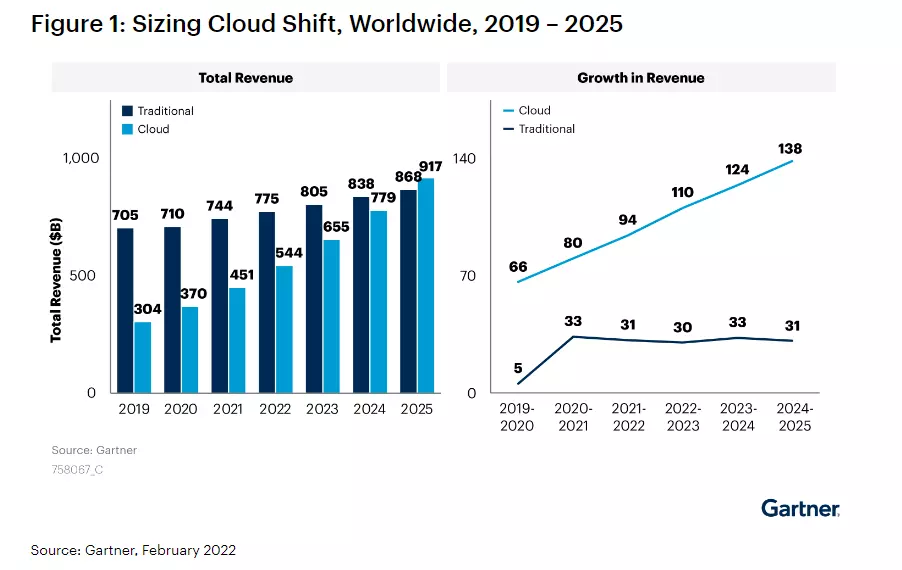In today’s digital landscape, data management has become an essential component for business success. Many organizations recognize the importance of big data analytics, with 72% of them stating that it’s “very important” or “quite important” to accomplish business goals. This highlights the growing significance of managing data effectively. As we move forward into 2024, it’s critical for businesses to keep up with the latest trends in data management to maintain a competitive edge.

So, let’s take a closer look at the top five data management trends in 2024 and explore how they can help businesses stay ahead of the curve.
1. Cloud-Based Data Integration
Enterprises are rapidly moving to the cloud, recognizing the benefits of increased scalability, flexibility, and cost-effectiveness. In fact, according to Gartner analysts, more than 85% of organizations will embrace a cloud-first principle by 2025.

Source: Gartner
As companies continue to move their operations to the cloud, they are also adopting cloud-based data integration solutions, such as cloud data warehouses and data lakes. These platforms provide businesses with a centralized and scalable solution for managing their data, enabling faster and more efficient processing, and reducing costs.
In addition to cloud data integration solutions, companies are also adopting hybrid and multi-cloud environments. These approaches allow businesses to leverage the benefits of both cloud-based and on-premises solutions, as well as multiple cloud-based solutions from different providers, to create a more resilient and flexible data integration environment.
Cloud computing offers businesses the significant advantage of enabling secure access to data from anywhere, at any time. This is particularly important in today’s business landscape, where remote work and distributed teams are becoming increasingly common.
As the trend towards cloud-based data integration, hybrid and multi-cloud environments continues to grow, businesses that adopt these solutions will be better positioned to manage their data more efficiently, leading to improved performance, better customer experiences, and ultimately, increased profitability.
2. Automation & AI
According to a recent report by IDC, revenue generated from AI and automation technologies is expected to reach $432.8 billion by 2022, with a compound annual growth rate (CAGR) of 19.6%. This highlights the need for businesses to embrace these technologies to stay ahead of the curve.
One of the key areas impacted by automation and AI is data processing, enabling businesses to reduce errors, improve accuracy, and make more informed decisions based on high-quality enterprise data.
AI and automation are revolutionizing data visualization by using machine learning algorithms to create visual representations of data that can uncover hidden insights and patterns.
In addition to these use cases, automation and AI are being applied across a range of data integration tasks, including data security, data synchronization, and data migration. By automating these processes and leveraging AI algorithms, businesses can streamline the data integration process and position themselves for success in the rapidly evolving world of data management.
3. Data Security and Privacy
Data privacy and security are critical concerns for businesses in today’s data-driven economy. As the volume of data generated and processed continues to increase, so do the risks associated with managing and protecting it. According to a recent study by IBM, the average cost of a data breach is $4.85 million, making data privacy and security a top priority for businesses.
In 2024, we can expect to see tighter data privacy and security measures in data integration, with more businesses adopting encryption technologies to ensure data privacy and security. Access control will also be an area of focus, with businesses limiting data access to those who need it and monitoring data access logs. Additionally, as more businesses move their data to the cloud, there will be a greater emphasis on cloud security to protect against data breaches and cyber-attacks.
By adopting the latest security technologies and working closely with cloud service providers, businesses can ensure that their data is protected and secure, enabling them to thrive in the digital era of the future.
4. Self-Service Solutions
Data integration has become a hot topic in the business world, and it’s not hard to see why. With data sources exploding in number, businesses are under more pressure than ever to integrate data quickly and easily from a range of sources. This is where self-service solutions for data integration come into play.
Self-service data integration is driven by the need for agility, flexibility, and speed in decision-making processes. In fact, according to the Experian 2020 Data Democratization Report, 81% of business leaders surveyed see data democratization, wherein access to data is provided to a wider audience, as a key initiative.
One of the main advantages of self-service data integration is that it empowers non-technical, business users to work with data, enabling them to bypass IT departments and reduce bottlenecks in data management. This means that businesses can quickly integrate data from sources such as cloud applications, databases, and APIs, providing them with greater flexibility and agility in their decision-making processes.
Self-service data integration is also highly user-friendly. Users can simply drag and drop data sources onto a visual interface, and the software takes care of the rest eliminating the need for extensive training.
Additionally, self-service data integration offers businesses flexibility to adapt to changing data sources and requirements. This is critical for staying agile and competitive in today’s fast-paced environment.
5. Real-time Data Integration
Every day, about 2.5 quintillion bytes of data are generated from various sources like mobile devices, social media, and the Internet of Things (IoT). Such an explosion in data can make it challenging for companies to keep up, let alone make informed decisions based on this data.
This is where real-time data integration comes into play. With the ability to access and analyze data in real-time, businesses can make informed decisions based on the most up-to-date information available. The reliance on batch processing to integrate data is no longer enough. With real-time data integration, businesses can gain valuable insights, respond to changes in the market quickly, and stay ahead of the competition.
The significance of real-time data integration also extends to the customer experience. Customers now expect businesses to be more responsive and provide personalized experiences. Real-time data integration enables businesses to gather and analyze customer data in real-time, allowing them to provide more relevant and timely offers and services to their customers.
Real time data integration is not just a trend, but a necessity in today’s fast-paced environment. Therefore, it is imperative for businesses to invest in to gain a competitive edge and make data-driven decisions.
Navigating Data Management and Integration Trends with Astera Centerprise
Astera Centerprise is a no-code, enterprise-grade data integration solution. Its powerful, industrial strength engine and robust features position the platform at the forefront of data integration needs.
With Astera Centerprise, you can:
- Extract data from various sources and transfer it seamlessly to the destination of your choice using native connectors.
- Connect effortlessly to popular cloud databases, data warehouses, and data lakes such as Snowflake, Amazon S3, Microsoft Blob Storage, and more.
- Establish and enforce data quality rules to ensure clean and consistent data across all environments.
- Optimize data integration with advanced automation capabilities that significantly reduce data latency and accelerate the overall process.
Ready to take your data integration to the next level? Try Centerprise by downloading our 14-day free trial today to streamline your workflows.






